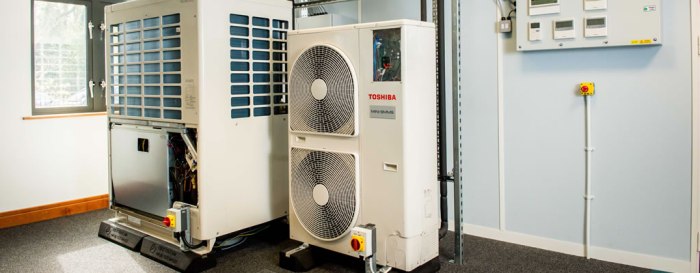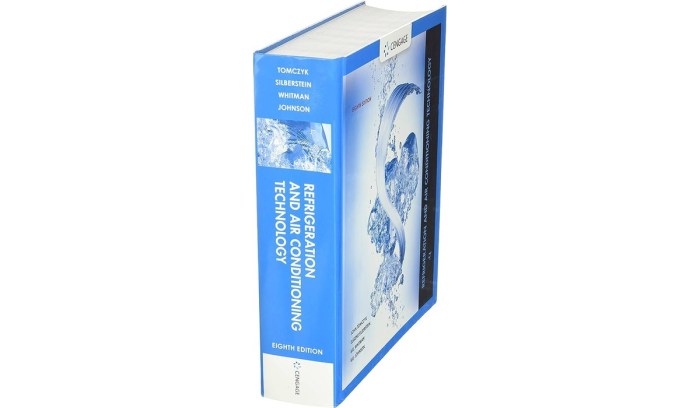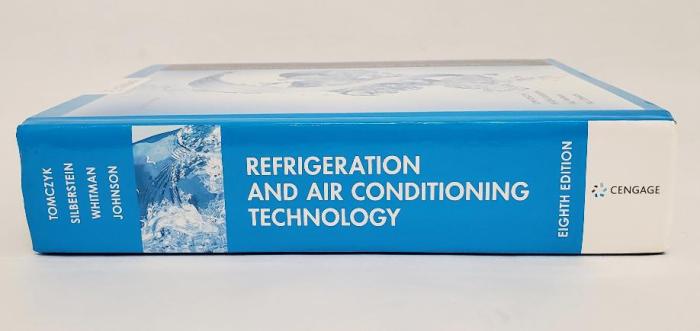Refrigeration and air conditioning technology 8th edition – Refrigeration and Air Conditioning Technology, 8th Edition is a comprehensive and authoritative guide to the latest advancements in this essential field. This edition provides readers with an in-depth understanding of the principles, design, and maintenance of refrigeration and air conditioning systems.
This book covers a wide range of topics, including the basic principles of refrigeration and air conditioning, the different types of systems available, and the major components of these systems. It also provides guidance on the design and maintenance of refrigeration and air conditioning systems, as well as the latest advancements in this field.
Refrigeration Systems

Refrigeration systems are devices that remove heat from a space or object, thereby lowering its temperature. They are used in a wide variety of applications, including food preservation, air conditioning, and industrial processes.
The basic principle of refrigeration is the use of a refrigerant, a substance that can change from a liquid to a gas and back again. When a refrigerant evaporates, it absorbs heat from its surroundings. This heat is then released when the refrigerant condenses back into a liquid.
Types of Refrigeration Systems
- Vapor-compression systems: These are the most common type of refrigeration system. They use a compressor to increase the pressure of the refrigerant, which causes it to condense. The heat released during condensation is removed by a condenser, and the liquid refrigerant is then expanded through an expansion valve, which causes it to evaporate and absorb heat.
- Absorption systems: These systems use a heat source to drive the refrigeration cycle. The heat source can be a flame, an electric heating element, or solar energy. Absorption systems are typically less efficient than vapor-compression systems, but they are quieter and can be used in applications where electricity is not available.
- Thermoelectric systems: These systems use the Peltier effect to create a temperature difference. When an electric current is passed through a thermoelectric material, one side of the material becomes hot and the other side becomes cold. Thermoelectric systems are typically small and portable, but they are less efficient than vapor-compression systems.
Applications of Refrigeration Systems
- Food preservation: Refrigeration is used to preserve food by slowing down the growth of bacteria. Refrigerators and freezers are common household appliances used for this purpose.
- Air conditioning: Refrigeration is used to cool air in buildings and vehicles. Air conditioners remove heat from the air, making it more comfortable for people to live and work in.
- Industrial processes: Refrigeration is used in a variety of industrial processes, such as food processing, chemical processing, and manufacturing.
- Central air conditioning systems: These systems are installed in a central location, such as a basement or attic, and distribute cooled air throughout a building through a network of ducts. Central air conditioning systems are typically more efficient than window units and portable air conditioners, but they are also more expensive to install.
- Window air conditioners: These units are installed in a window and cool a single room. Window air conditioners are less expensive than central air conditioning systems, but they are also less efficient and can be noisy.
- Portable air conditioners: These units are free-standing and can be moved from room to room. Portable air conditioners are less efficient than window units and central air conditioning systems, but they are also more portable and less expensive.
- Residential: Air conditioning is used to cool homes and apartments in hot climates. Air conditioners make it more comfortable for people to live and work in their homes.
- Commercial: Air conditioning is used to cool offices, stores, and other commercial buildings. Air conditioners make it more comfortable for people to work and shop in these buildings.
- Industrial: Air conditioning is used to cool factories, warehouses, and other industrial buildings. Air conditioners make it more comfortable for people to work in these buildings and can also help to protect sensitive equipment from heat damage.
- Compressor: The compressor is the heart of the refrigeration or air conditioning system. It compresses the refrigerant, which increases its pressure and temperature.
- Condenser: The condenser is a heat exchanger that removes heat from the refrigerant. The heat is transferred to the outside air or water.
- Expansion valve: The expansion valve is a device that controls the flow of refrigerant into the evaporator. The expansion valve regulates the amount of refrigerant that is evaporated, which in turn controls the cooling capacity of the system.
- Evaporator: The evaporator is a heat exchanger that absorbs heat from the space or object being cooled. The heat is transferred to the refrigerant, which evaporates.
Air Conditioning Systems

Air conditioning systems are devices that control the temperature, humidity, and air quality in a space. They are used in a wide variety of applications, including residential, commercial, and industrial.
The basic principle of air conditioning is the use of a refrigerant, a substance that can change from a liquid to a gas and back again. When a refrigerant evaporates, it absorbs heat from its surroundings. This heat is then released when the refrigerant condenses back into a liquid.
Types of Air Conditioning Systems, Refrigeration and air conditioning technology 8th edition
Applications of Air Conditioning Systems
Refrigeration and Air Conditioning Components: Refrigeration And Air Conditioning Technology 8th Edition

Refrigeration and air conditioning systems are made up of a variety of components, including:
In addition to these main components, refrigeration and air conditioning systems may also include a variety of other components, such as filters, fans, and controls.
Detailed FAQs
What are the different types of refrigeration systems?
There are two main types of refrigeration systems: vapor-compression systems and absorption systems.
What are the different types of air conditioning systems?
There are three main types of air conditioning systems: central systems, split systems, and packaged systems.
What are the major components of a refrigeration system?
The major components of a refrigeration system include the compressor, condenser, evaporator, and expansion device.